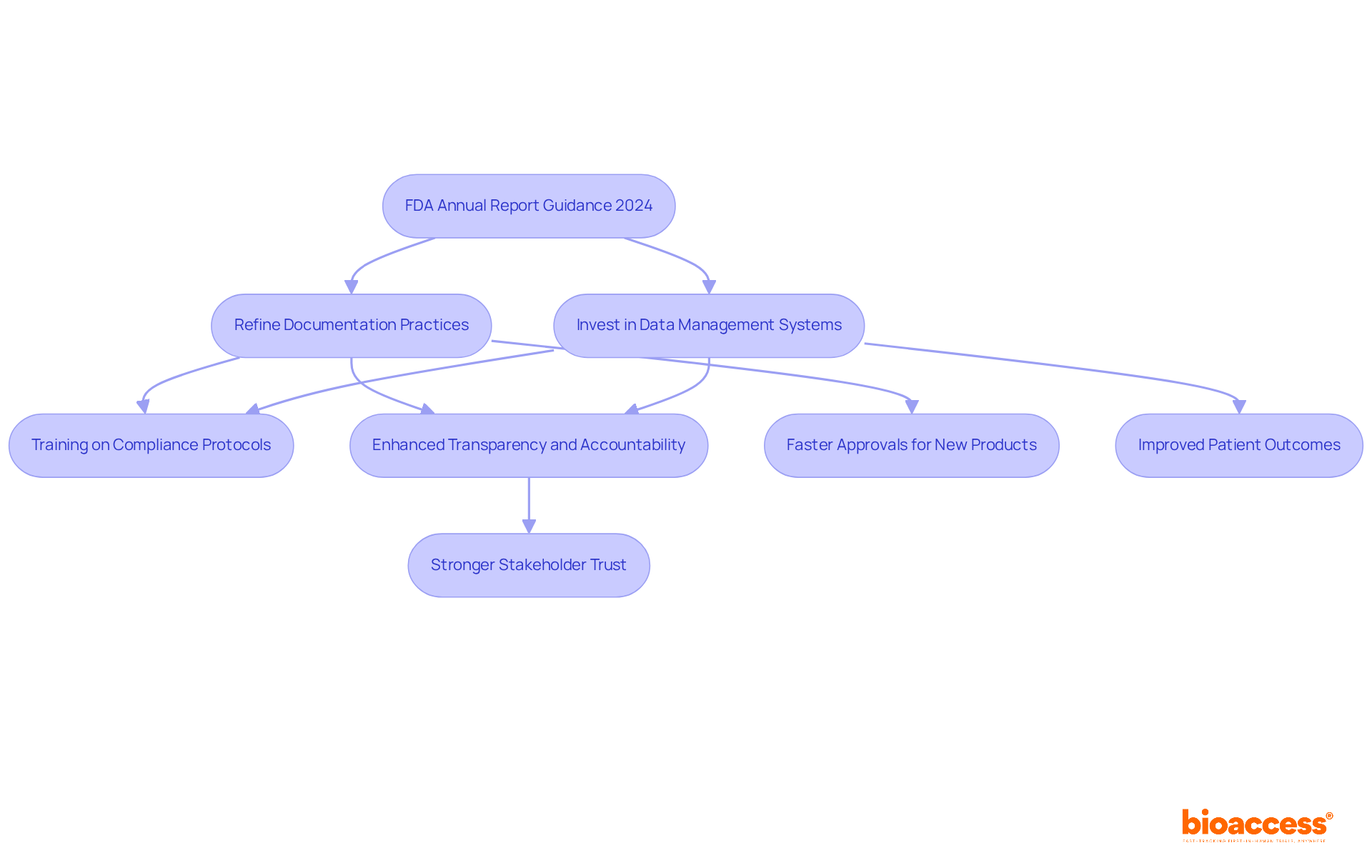


The FDA's annual report guidance for 2024 establishes critical expectations for companies regarding the documentation of research studies and product performance. This guidance emphasizes the need for transparency and accountability in the regulatory process, making it highly relevant to clinical research. Specific requirements, such as:
are detailed in the article. These elements are essential for enhancing public health and ensuring that companies align with FDA standards. By facilitating timely approvals, this guidance ultimately aims to improve patient outcomes.
The FDA's annual report guidance for 2024 emerges as a critical framework that shapes the landscape of medical research and product development. This guidance establishes stringent reporting requirements and emphasizes the importance of transparency and accountability in fostering public trust. As companies navigate the complexities of compliance, they confront a pressing question: how can they effectively align their practices with these evolving standards while ensuring the safety and efficacy of their innovations?
The FDA annual report guidance for 2024 outlines essential expectations and requirements for companies concerning the documentation of research studies and product performance. This guidance establishes a robust framework designed to foster transparency and accountability within the research landscape. Key directives encompass specific data types that must be reported, submission timelines, and the required format for presenting this information. Compliance with these guidelines is paramount, as it not only aligns with FDA regulations but also bolsters public health and safety by ensuring that critical information is readily accessible.
In 2024, the FDA approved a total of 5,564 marketing submissions, which included 3,107 premarket applications and 120 innovative devices. This showcases the agency's unwavering dedication to upholding rigorous standards in research reporting and oversight. Furthermore, the heightened emphasis on cybersecurity in premarket submissions underscores the evolving regulatory landscape, necessitating that companies integrate quality and security into their operational processes. As Pradeep Singh aptly noted, "The standards set by the US FDA represent the highest level of service, which is consistently monitored to manage the risks associated with pharmaceuticals in relation to their cGMP regulations."
By following the FDA annual report guidance, organizations can enhance their credibility and contribute to the overarching goal of improving patient outcomes through transparent research practices. Katherine Ruiz's expertise in regulatory affairs for medical devices and in vitro diagnostics in Colombia further highlights the critical importance of effectively navigating these guidelines. Additionally, the significance of ClinicalTrials.gov in maintaining a comprehensive account of interventional studies cannot be overstated, as it plays a vital role in promoting transparency.
Noncompliance with these guidelines may result in severe consequences, including the issuance of Preliminary Notices of Noncompliance, thereby emphasizing the necessity for organizations to prioritize adherence to these standards.

The FDA, or Food and Drug Administration, plays a crucial role in safeguarding public health through its regulation of food, drugs, medical devices, and related health products. Established in 1906, the agency is dedicated to ensuring that these products are safe, effective, and accurately labeled. Its oversight of research studies is particularly vital, enforcing adherence to guidelines designed to protect participants and uphold the integrity of information. This regulatory framework is essential; approximately 80% of research studies fail to meet initial enrollment objectives, leading to significant revenue losses estimated at $8 million daily for drug development companies. By issuing FDA annual report guidance, the organization fosters transparency and accountability, thereby enhancing public trust in the healthcare system. Public health officials recognize that effective FDA regulations not only improve trial outcomes but also enhance the overall safety and efficacy of medical innovations, ultimately benefiting public health.
In Latin America, bioaccess® stands out as a leading contract research organization (CRO) that offers swift, economical, and high-quality research services tailored for Medtech startups. By collaborating with bioaccess®, companies can effectively navigate the complexities of regulatory approval, research site activation, and subject recruitment. This partnership accelerates the research process while improving the likelihood of meeting FDA standards, thereby supporting public health through successful medical advancements. With a comprehensive suite of research study management services—including feasibility studies, compliance reviews, study setup, import permits, project management, and reporting—bioaccess® significantly enhances the chances of success in research endeavors. This highlights the FDA's pivotal role in promoting successful medical innovations that not only advance public health but also contribute to local economies through job creation and healthcare improvement.

The FDA annual report guidance for 2024 outlines several essential components that companies must adhere to for successful submissions. These components include:
Data Reporting Requirements: Companies are required to report results from their research studies, encompassing both efficacy and safety information. This ensures that the FDA receives comprehensive insights into the performance of medical devices and drugs. Extensive clinical trial management services, like those provided by bioaccess, play an essential role in enabling precise data collection and analysis.
Submission Timelines: The FDA annual report guidance delineates specific deadlines for submitting annual reports, which are crucial for maintaining timely communication with the FDA. Adhering to these timelines is vital for compliance and can significantly impact the approval process. Bioaccess's project management services help ensure that all submissions are made on time.
Format Specifications: Companies must follow precise formatting guidelines to streamline the review process. Proper formatting not only aids in clarity but also enhances the likelihood of acceptance by the FDA. Compliance reviews conducted by bioaccess ensure that all documentation meets these specifications.
Compliance Metrics: The FDA annual report guidance specifies metrics that companies should monitor to demonstrate their adherence to FDA regulations. Tracking these metrics is essential for identifying areas of improvement and ensuring ongoing compliance. Bioaccess assists companies in establishing these metrics and monitoring their compliance effectively.
In 2024, the FDA approved more than 3,100 510(k) submissions and 2,217 PMA supplements, highlighting the significance of fulfilling these submission criteria. Companies that effectively align their documentation practices with FDA expectations can enhance their chances of timely approvals and successful market entry. For instance, organizations utilizing tools like Pinnacle 21 for data validation have reported improved compliance and expedited submission processes, showcasing the benefits of adhering to the guidance. By understanding and implementing these components, companies can better prepare their reports and ensure alignment with FDA standards.

The FDA annual report guidance for 2024 has significant implications for the Medtech and Biopharma sectors. Companies are required to refine their documentation practices to comply with the updated standards, necessitating investments in advanced data management systems and comprehensive staff training on compliance protocols. This shift towards enhanced transparency and accountability is poised to bolster stakeholder trust and strengthen relationships with regulatory authorities.
For instance, companies that consistently comply with requirements are likely to receive faster approvals for new products, greatly shortening their time to market. Moreover, the FDA annual report guidance encourages a proactive stance on data management, which can lead to improved patient outcomes and a more substantial clinical evidence base supporting product efficacy. In 2024, the CDRH received roughly 20,700 submissions, emphasizing the significance of strong documentation practices in effectively navigating the regulatory landscape.

For Medtech and Biopharma companies, complying with the FDA annual report guidance presents substantial challenges. A primary obstacle lies in the intricate nature of data gathering and analysis, which can be resource-intensive and time-consuming. Companies frequently face difficulties in integrating data from diverse sources while ensuring its accuracy. The dynamic regulatory landscape further complicates this issue; organizations must remain vigilant about updates to guidance, necessitating continuous training and adaptation.
To address these challenges, investing in comprehensive clinical study management services, such as those offered by bioaccess, is crucial. Our capabilities encompass:
All designed to streamline data integration and enhance accuracy. Additionally, fostering a culture of compliance within the organization can significantly improve adherence to the FDA annual report guidance. Engaging with regulatory experts, such as Katherine Ruiz, who specializes in regulatory affairs for medical devices and in vitro diagnostics in Colombia, can provide essential insights and support, aiding companies in navigating the complexities of FDA compliance effectively.
Statistics reveal that less than 10% of significant adverse events are reported by healthcare professionals, underscoring the urgent need for enhanced data collection mechanisms and the implications this has for compliance and safety monitoring. Furthermore, the average time required to finalize adverse event documentation is estimated at 40 minutes, highlighting the resource demands associated with compliance. By prioritizing these strategies and leveraging the expertise of professionals like Juan Cuya, MD, companies can better position themselves to meet FDA reporting requirements and enhance their operational efficiency.

The FDA Annual Report Guidance for 2024 serves as a critical framework for companies in the Medtech and Biopharma industries, underscoring the necessity of transparency and accountability in research practices. This guidance not only delineates essential reporting requirements but also reinforces the FDA's commitment to safeguarding public health through rigorous oversight and compliance standards.
Key insights throughout the article reveal the imperative of adhering to specific data reporting requirements, submission timelines, and formatting guidelines. Companies that adeptly navigate these directives can enhance their credibility and expedite their product approval processes. The discussion further highlights the challenges organizations encounter in meeting these standards, emphasizing the need for effective data management systems and a culture of compliance to ensure ongoing adherence to FDA regulations.
In reflection, the implications of the FDA Annual Report Guidance transcend mere regulatory compliance; they present an opportunity for companies to positively impact public health outcomes. By prioritizing transparency and quality in their research practices, organizations can improve their market positioning, foster trust among stakeholders, and enhance the overall safety and efficacy of medical innovations. Embracing these guidelines is not merely a regulatory obligation but a crucial step toward advancing healthcare and benefiting society as a whole.
What is the FDA annual report guidance for 2024?
The FDA annual report guidance for 2024 outlines expectations and requirements for companies regarding the documentation of research studies and product performance, focusing on transparency and accountability.
Why is compliance with the FDA annual report guidance important?
Compliance is crucial as it aligns with FDA regulations and enhances public health and safety by ensuring critical information is readily accessible.
What types of submissions did the FDA approve in 2024?
In 2024, the FDA approved a total of 5,564 marketing submissions, which included 3,107 premarket applications and 120 innovative devices.
What emphasis has the FDA placed on cybersecurity in 2024?
The FDA has heightened its emphasis on cybersecurity in premarket submissions, requiring companies to integrate quality and security into their operational processes.
How can organizations benefit from following the FDA annual report guidance?
Organizations can enhance their credibility and contribute to improving patient outcomes through transparent research practices by following the FDA guidelines.
What role does ClinicalTrials.gov play in research?
ClinicalTrials.gov maintains a comprehensive account of interventional studies, promoting transparency in research practices.
What are the consequences of noncompliance with FDA guidelines?
Noncompliance may result in severe consequences, including the issuance of Preliminary Notices of Noncompliance.
What is the FDA's role in public health?
The FDA safeguards public health by regulating food, drugs, medical devices, and related health products, ensuring they are safe, effective, and accurately labeled.
How do FDA regulations impact research studies?
FDA regulations enforce adherence to guidelines that protect research participants and uphold the integrity of information, which is crucial for successful trial outcomes.
What is bioaccess® and how does it relate to FDA standards?
Bioaccess® is a leading contract research organization in Latin America that offers research services for Medtech startups, helping them navigate regulatory approval and improve their chances of meeting FDA standards.